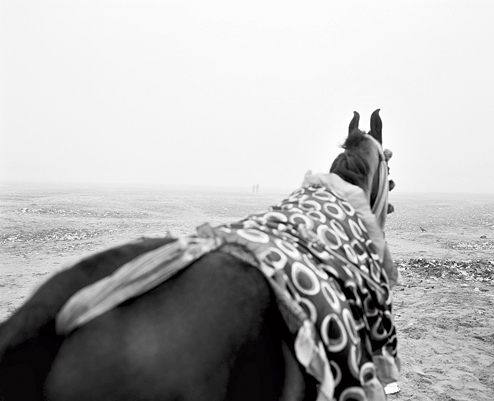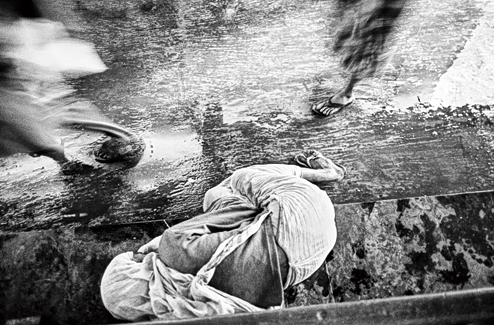Saibal Das’s exhibition of black-and-white photographs (silver gelatin prints), Before the birth of Time, at The Harrington Street Arts Centre in collaboration with Tasveer lifts the veil over a world that once India was identified with, but is hardly visible anymore, now that the entire country has turned into a marketplace which has no connect with the more contemplative side of life.
Das, a veteran photojournalist, began his quest for a way of life where money and the principles it represents have little value, about four years ago when he visited Nabadwip, where the Vaishnavs have little use for material possessions. Over the next three years he travelled to Vrindaban, Puri and Manipur, which are regarded as the seats of Vaishnavism in India.
This world is sombre, pensive and at times sad, but it can also be charming and even quaint. A woman stands alone by the tulsimancha in Vishnupriya’s home in Nabadwip. The effigy of her beautiful, lotus-eyed husband, Chaitanya Mahaprabhu, is worshipped in a shrine in Puri. Whether by accident or design, behind him is a mural of Hanuman, the symbol of strength and prowess. A young woman, who has come to worship the sun during Chhat puja, is lost in thought. Behind her is a vast expanse of water from which sugarcane sprout like rushes. A smile plays on the lips of a buxom woman who has also come to the riverside along with other worshippers.

An old woman with an unlined face in a white sari and folded hands sits alone in a huge hall. A pinpoint of light illumines her dark eyes. She is calm and no sorrow can touch her any longer. Another old woman lies beneath the staircase of a shrine as people pass by hurriedly, their feet blurred by speed. But not all women are so resigned. The old women who are being initiated into Nagahood look tough and strong, both physically and mentally. A royal lady is the very picture of dignity as she sits on her bed.
In this world one walks alone. This is perhaps symbolised by the stray pair of rubber slippers resting upright on a wall clawed and mutilated by the hands of time. There are also the ash-covered mendicants who are absorbed in their own world while playing the flute or telling their rosary. As solitary as these wandering figures is a horse standing in a dry riverbed. On the horizon are two human beings reduced to specks.
But it is not all sadness and gloom. An unwilling child dressed as Krishna holds on desperately to the waistband of a man as he is perhaps being led to a dais. The ceremonial guards of a temple in Manipur sit with their spears amidst a vast hall. The turbaned cooks with statuesque physique of the same temple have their mouths covered with cloth so as not to pollute the food for god.
Das’s most powerful photographs are those of the Manikarnika burning ghat where countless human beings are cremated. He never shows the grotesque half-burnt bodies floating in the river. Instead, his focus is on the mountains of logs used for the funeral pyres. They are piled up on the staircases and on the boats by the bank. The wood is being sold by the kilogram. An old woman is busy tying something in the pallu of her sari. She looks elsewhere. Her attention has been distracted. Behind her rises a wall of logs. In another photograph, smoke rises from a pyre in the distance, blurring the buildings behind it. In the foreground is the massive back of a man with a shaven head.
source: http://www.telegraphindia.com / The Telegraph, Calcutta / Front Page> Calcutta> Story / by Soumitra Das / Sunday – March 08th, 2015
